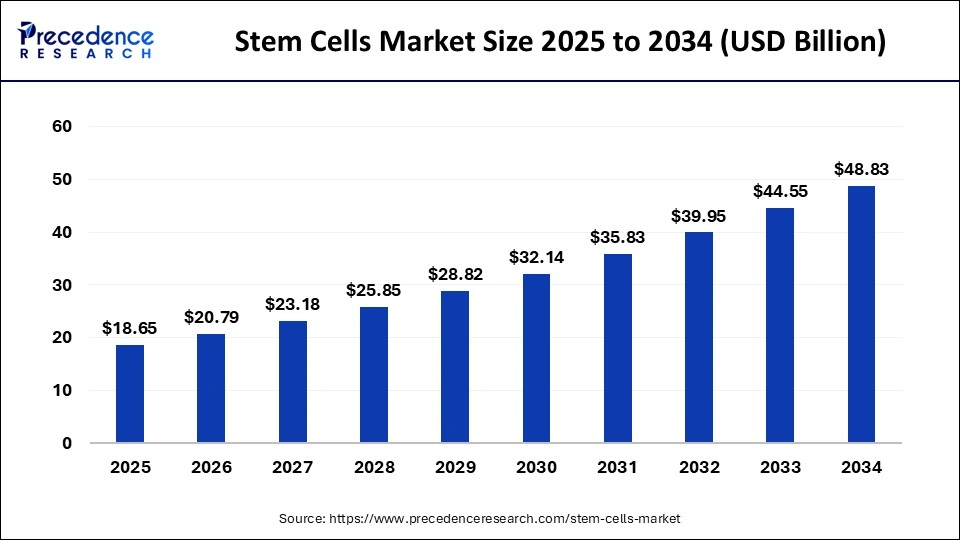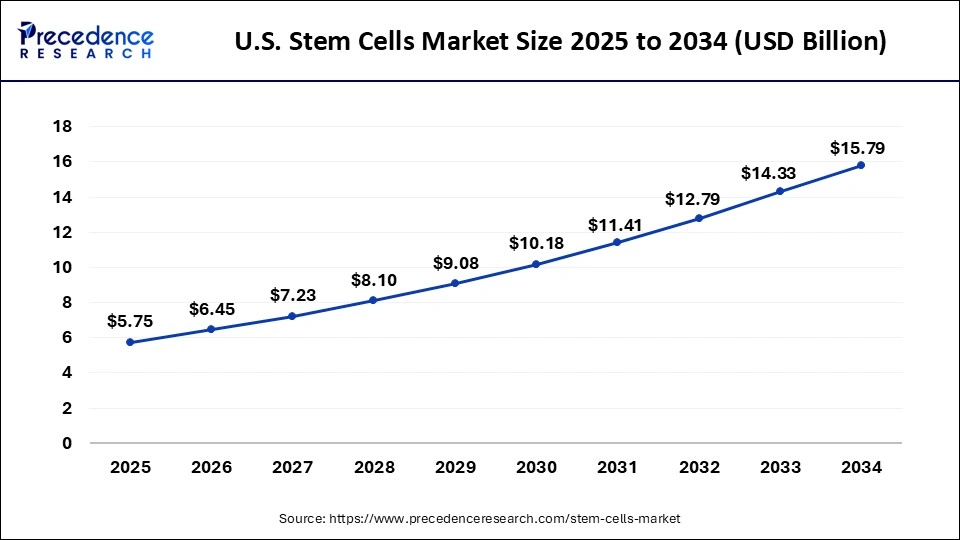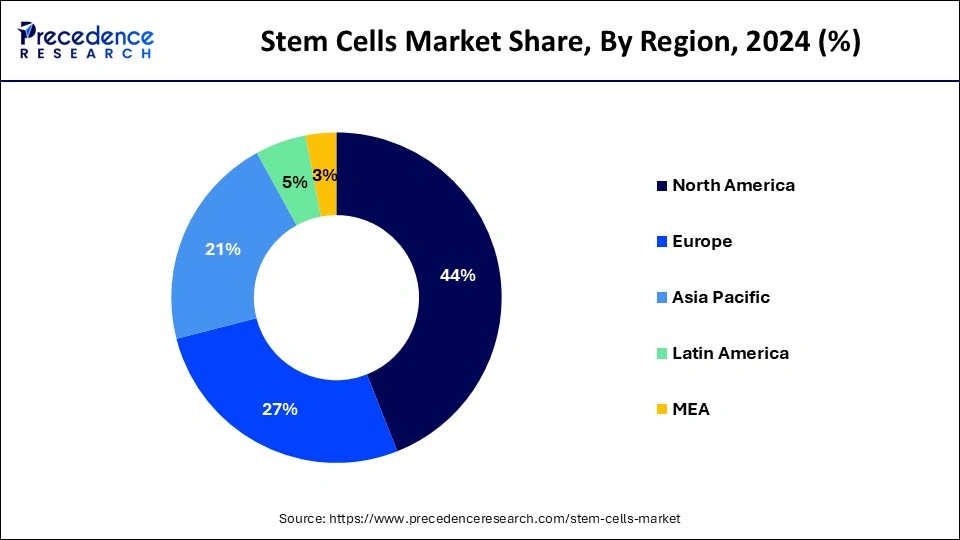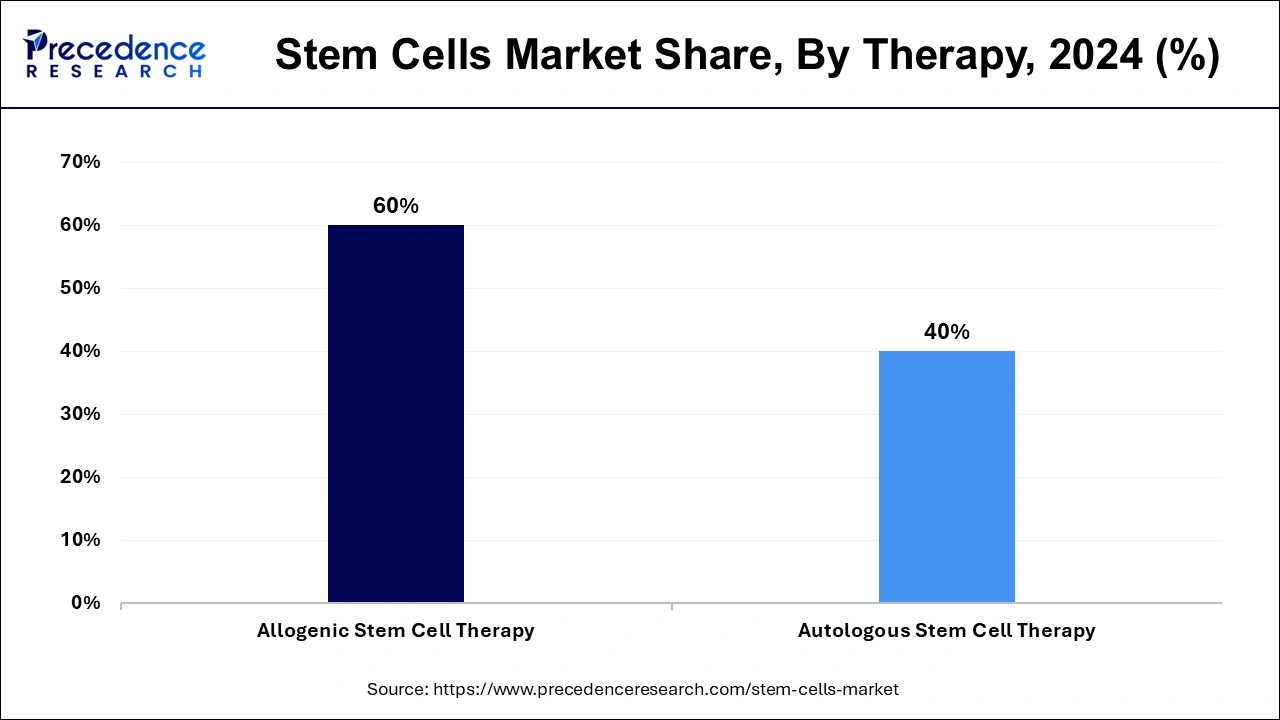January 2025
The global stem cells market size is calculated at USD 18.65 billion in 2025 and is forecasted to reach around USD 48.83 billion by 2034, accelerating at a CAGR of 11.30% from 2025 to 2034. The North America stem cells market size surpassed USD 7.36 billion in 2024 and is expanding at a CAGR of 11.32% during the forecast period. The market sizing and forecasts are revenue-based (USD Million/Billion), with 2024 as the base year.
The global stem cells market size was valued at USD 16.73 billion in 2024 is expected to reach around USD 48.83 billion by 2034, expanding at a CAGR of 11.30% from 2025 to 2034.

The U.S. stem cells market size was estimated at USD 5.13 billion in 2024 and is predicted to be worth around USD 15.79 billion by 2034, at a CAGR of 11.9% from 2025 to 2034.

In 2024, North America led the stem cells market in terms of revenue owing to huge R&D investments in cytological research. The increased number of clinical trials undergoing in the U.S. also drives the market growth in this region.Stem cells are highly used in regenerative medicines particularly in the dermatology sector. The U.S. and Canada with their well-developed healthcare infrastructure will encourage research and development activities and emerging players.

Stem cells market in Asia Pacific grows with the high CAGR on account of robust product pipelines in cell-based therapies and a huge patient pool.
Global stem cells have acquired noteworthy attention from the multi-sectored community of scientists. Growing investment in stem cells research and the exponential success of regenerative medicines are projected to propel the market growth. Another growth rendering factor for the global stem cells market is increasing number of clinical trials across the globe. Stem cell technology has garner importance over the last few years as it is used to treat the diseased organs, damaged tissues and regenerative medicines. Increasing number of stem cells banking and government initiatives drives the growth of the stem cells market in emerging countries.
Additionally, growing awareness among regarding storage of stem cells has positively impacted the market propagation. However, growing awareness about alternative procedures is likely to hinder the market growth. Nonetheless, growing stem cell-based research and investment by pharmaceutical and biopharmaceutical companies will significantly propel the market growth over the forecast period.
| Report Highlights | Details |
| Growth Rate from 2025 to 2034 | CAGR of 11.30% |
| Market Size in 2024 | USD 16.73 Billion |
| Market Size in 2025 | USD 18.65 Billion |
| Market Size by 2034 | USD 48.83 Billion |
| Base Year | 2024 |
| Forecast Region | 2025 to 2034 |
| Segments Covered | By Product, By Application, By Technology, and By Therapy |
| Regional Scope | North America, APAC, Europe, Latin America, MEAN, Rest of the World |
Rising application in research and therapies
Stem cell products are widely used in various applications that include research and therapies such as medicines. Rising demand for regenerative medicines is one of the major factors proliferating the growth of the market. Increasing popularity for stell cells among researchers and clinicians to develop regenerative medicines is also triggering the potential demand in the industry. In July 2022, Bio Techno, which manufactures develops, and sells science reagents acquired Namocell, a US-based company that deals in providing instruments and consumables required for gene therapy.
Business activities in the industry
Stem cell products are increasingly becoming popular in pharmaceutical companies. The rising need for effective stem cell therapies for neurological disorders is leading to a surge in research and development activities in the market. Growing collaborative activities between pharmaceutical and biotechnological companies is triggering the growth of the industry. For example, In July 2023, Pluristyx partnered with Stem Genomics. Through the collaboration, the businesses will provide a standardized method for users to access the genomic stability of Pluristyx's pluripotent stem cell (PSC) lines using the ICS-digital PSC test from Stem Genomics.
Ethical and regulatory issues
The stem cell market has proven effective in the treatment of new diseases such as diabetes, and spinal cord injury. However, some countries and regions have put restrictions on certain stell cell research which is further limiting the growth of the market. Human embryonic stem cell research involves damaging human embryos to create cell lines. Furthermore, the risks associated with stem cell plantation include unsuitable mitigation of stem cells.
High cost of treatment
The high cost associated with stem cells is observed to limit the growth of the market. Stem treatment has come as an effective option in treating various chronic diseases. Developing stem cell-based therapies is also costly and time-consuming. The research and development process, as well as the need for clinical trials and regulatory approvals, require significant financial investments.
Rising demand for regenerative medicines
The demand for regenerative medicines is experiencing major popularity. Stell cells hold great potential for regenerating damaged or diseased tissues and organs. The therapies assist in treating various diseases including heart disease, and diabetes. Advancements in stem cell research also enable the development of personalized treatments based on a patient's stem cells, reducing the risk of rejection and improving treatment outcomes.
In terms of application segments, the oncology segments exhibited the highest growth rate owing to the existence of various pipeline products for the treatment of cancer and tumors. Increasing regenerative medicine centers are expected to increase the prospects for stem cells in the near future.
Depending upon the product, the global stem cell market is classified into adult stem cell, human embryonic stem cells, very small embryonic like stem cell, and induced pluripotent stem cell.
Among these, adult stem cells dominated the global market in 2024 and is expected to hold the dominance over the forecast period owing to less contamination risk integrated with sub-culturing, less need of production labor and compatibility with the human body.
Amidst different technology segments, the cell acquisition technology dominated the stem cells market in 2024. Increasing awareness about the exponential significance of stem cells has propel to noteworthy growth in cell harvesting, which resulting in growth in the global stem cells market. Generally, the most common method used in order to cell acquisition is the bone marrow harvest as the tissues recovery from bone marrow stem cells is relatively faster.
The allogeneic segment is estimated to hold the highest market share of 60% in 2024. The benefit of allogeneic stem cell is that the donor stem cells male their own immune cells which can help destroy cancer cells that may remain after high-dose treatment. This graft-versus-cancer is used in prevention of cancer relapse. The incidences of cancer relapse increasing significantly, generally it takes place within 1 year after therapy and these happenings are noticed in children and people suffering from oropharyngeal and breast cancer These facts are in turn accelerating growth of allergic therapies segment.

The autologous segment is expected to grow at robust growth rate over the forecast period owing to low risk associated with autologous therapy.Another major factor expected to fuel the growth include increased survival, affordability, reduced risk of graft-versus-host diseases and no requirement for recognition of HLA-matched donor.
By Product
By Application
By Technology
By Therapy
By Regional Outlook
For inquiries regarding discounts, bulk purchases, or customization requests, please contact us at sales@precedenceresearch.com
No cookie-cutter, only authentic analysis – take the 1st step to become a Precedence Research client
January 2025
February 2025
February 2025
February 2025